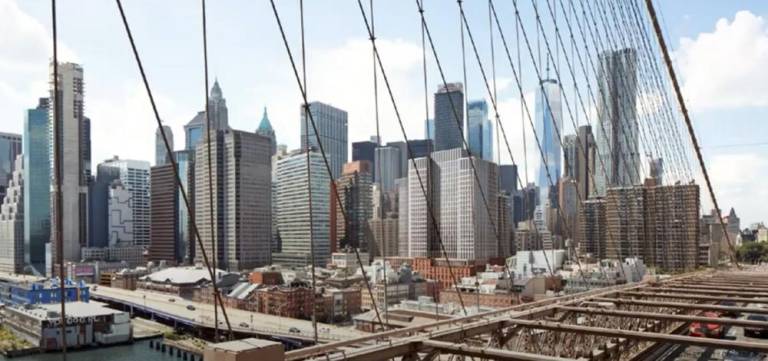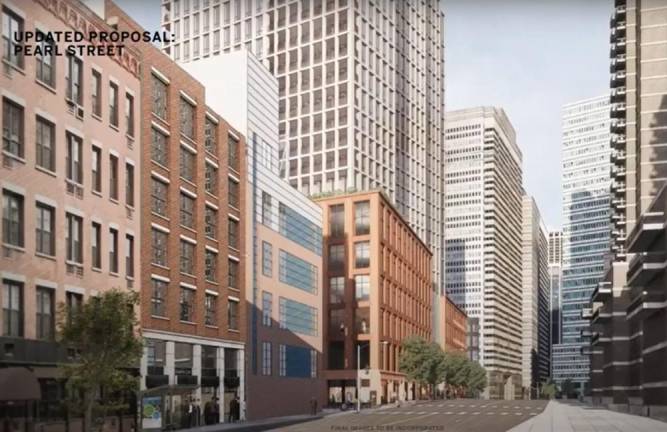A New Seaport Design
Howard Hughes Corporation presents revised plan for 250 Water Street, but CB1 committee members aren’t swayed


Last week, the Howard Hughes Corporation presented its revised design – one that is reduced in height and bulk – for a proposal of a mixed-use development at 250 Water Street to Community Board 1’s landmarks committee in hopes of appeasing the project’s critics – but the sentiment of those on the board does not seem to have shifted.
HHC was sent back to the drawing board in January when the Landmark Preservation Commission – which must rubber stamp the project before it can move forward – declined to take action on its applications for development in the South Street Seaport Historic District, which included two separate projects: a pair of 470-foot towers consisting of a mix of affordable housing units and market-rate condos at 250 Water Street and a new building for the South Street Seaport Museum at nearby 173-69 John Street.
The LPC members spoke favorably of the museum expansion, but found the height and bulk of the residential towers to be out of context with the low-rise buildings of the Seaport, where the tallest building is 108 feet, and told HHC to try again.
Chris Cooper, of SOM Designs, laid out HHC’s revised 250 Water Street proposal for members of CB1’s landmarks committee Thursday evening, describing this design as less imposing on the historic district. In the new design, the towers have been dropped in favor of a bar building topping out at 345 feet. The square footage has also been reduced from 757,000 square feet to 550,000. Altogether, the building will consist of 27 floors: 15 floors of condos, four floors of affordable apartments, six floors of office space, with the bottom floor serving as retail and community space.
With the reduction in size, the number of affordable rental units has also decreased from 100 to 70. These units would be available to families and individuals earning roughly $45,000 per year.
In his presentation, Cooper said the design team made other adjustments in response to the feedback of the original design, which included shifting the bulk of the tower toward Pearl Street, where more modern buildings start to make up the cityscape. Sitting atop a 90-foot base, the residential floors would be set off from Water and Beekman streets – where buildings are more indicative of the historic district in scale and architecture. The residential floors would be 45 feet off from Water Street and 90 feet from Beekman Street.
“We’ve worked hard to redesign our project to directly respond to the Landmarks Preservation Commission’s comments while preserving two of the project’s most crucial elements: deeply affordable housing in one of the city’s wealthiest neighborhoods and meaningful funding for the South Street Seaport Museum, which is the heart of the Historic District and reason for its existence,” HHC New York Tri-State President Saul Scherl said in a statement. “As the neighborhood and the city turn toward recovery from the pandemic, we have an opportunity to transform a parking lot with no historic value into a nearly billion-dollar investment that supports the long-term viability of the Museum and creates Lower Manhattan’s most significant affordable housing in decades -- and we are committed to seeing it through.”
“Inelegant” Design
The committee members, however, were not swayed by the new design.
“I think you’ve been tasked with the impossible of trying to fit something of this bulk and size [in this lot],” said committee member Vera Sung. “[The design] is heavy in every sense.”
That was the consensus among committee members Thursday, that the reductions in height and square footage were still not enough to conform to the district’s low-rise setup.
“The variance is so significantly above the as-of-right development rights and it’s just not appropriate at this location,” said Elizabeth Lamere. “I also don’t think we need 19 stories of luxury condos at the detriment to residents who had lived in this area for generations and whose light and air is being significantly compromised.”
Two other committees said they found the design to be “inelegant.”
Others spoke to the project’s tie to the museum, which has caused great friction in the community. If HHC is given the greenlight to construct the tower at Water Street, the corporation has vowed to gift the long suffering museum $50 million, which museum board members have said $10 million would be used to renovate the existing building and the rest would be put in an endowment. In the opponents’ view, which was reiterated by committee members Thursday, there are doubts that the new museum headquarters would ever be built, as the gifted money would not fund the construction, which is expected to cost around $40 million.
Supporters of the project claim this is the only way to open the museum for the first time since Hurricane Sandy, and ultimately, keep it from sinking.
“Historic Opportunity”
Board member Tom Berton, who has worked for HHC in the past, spoke favorably of the company and the proposal.
“I want to reiterate my sadness that the landmarks committee and community is so dead set against this private-public partnership that is being supported and begged for by the museum,” said Berton. He said he was skeptical of claims that there are other solutions to the museum’s financial situation, considering it has been a longtime issue and has yet to be solved.
“I think this is a historic opportunity at an inflection point for our country and city, and I just wish there was a way to move forward and work with [HHC] instead of rejecting it out of hand,” said Berton.
Mariana James, another board member, also spoke favorably of HHC and their record of working with Black business owners.
“The fact remains there are few Black-owned businesses in this district, and Howard Hughes houses one of the few,” said James. “I think there are potentially grave racial impacts in considering who gets or who doesn’t get to develop here. Or what gets developed here, and whether or not Black and brown people or members of the LGBTQ community have equal access to those contracts and spaces.”
The landmarks committee and the full community board will vote on resolutions whether to recommend the LPC approve HHC’s applications before the LPC is expected to take up the issue again in April.
If approved by the LPC, the proposal would also have to go through the city’s Uniform Land Use Review Procedure. If the LPC rejects this new design, a spokesperson told the New York Post HHC would develop the site as of right, meaning no affordable housing units and no funding for the museum.
“The fact remains there are few Black-owned businesses in this district, and Howard Hughes houses one of the few. I think there are potentially grave racial impacts in considering who gets or who doesn’t get to develop here.” Board member Mariana James